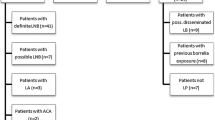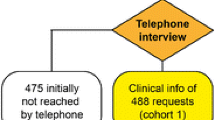Abstract
The aim of this study was to evaluate the polymerase chain reaction (PCR) as a diagnostic tool for Lyme borreliosis on large numbers of samples from clinically well-defined cases of early and late cutaneous borreliosis. Skin biopsy specimens from patients with erythema migrans and acrodermatitis chronica atrophicans were analysed blindly together with an equal number of control biopsies. Using two different dilutions of each DNA specimen increased the number of total positives detected. All of the 76 control biopsies were PCR negative. Biopsy specimens from 18 of 26 (69 %) erythema migrans lesions and from 22 of 36 (61 %) acrodermatitis chronica atrophicans lesions were PCR positive. Fourteen post-therapy biopsies from patients with acrodermatitis chronica atrophicans were all negative, supporting the opinion that antibiotic therapy is successful in this chronic manifestation of Lyme borreliosis.
Similar content being viewed by others
References
Jaulhac B, Nicolini P, Piemont Y, Monteil H: Detection ofBorrelia burgdorferi in cerebrospinal fluid of patients with Lyme borreliosis. New England Journal of Medicine 1991, 234: 1440.
Debue M, Gautier P, Hackel C, Van Elsen A, Herzog A, Bigaignon G, Bollen A: Detection ofBorrelia burgdorferi in biological samples using the polymerase chain reaction assay. Research in Microbiology 1991, 142: 565–572.
Lebech A-M, Hansen K: Detection ofBorrelia burgdorferi DNA in urine samples and cerebrospinal fluid samples from patients with early and late Lyme neuroborreliosis by polymerase chain reaction. Journal of Clinical Microbiology 1992, 30: 1646–1653.
Keller TL, Halperin JJ, Whitman M: PCR detection ofBorrelia burgdorferi DNA in cerebrospinal fluid of Lyme neuroborreliosis patients. Neurology 1992, 42: 32–42.
Luft BJ, Steinman CR, Neimark HC, Muralidhar B, Rush T, Finkel MF, Kunkel M, Dattwyler J: Invasion of the central nervous system byBorrelia burgdorferi in acute disseminated infection. Journal of the American Medical Association 1992, 267: 1364–1367.
Amouriaux P, Assous M, Margarita D, Baranton G, Saint Giron I: Polymerase chain reaction with the 30-kb circular plasmid ofBorrelia burgdorferi B31 as a target for detection of the Lyme borreliosis agents in cerebrospinal fluid. Research in Microbiology 1993, 144: 211–219.
Liebling MR, Nishio MJ, Rodriguez A, Sigal LH, Jin T, Louie JS: The polymerase chain reaction for the detection ofBorrelia burgdorferi in human body fluids. Arthritis and Rheumatism 1993, 36: 665–675.
Goodman JL, Jurkovich P, Kramber JM, Johnson RC: Molecular detection of persistentBorrelia burgdorferi in the urine of patients with active Lyme disease. Infection and Immunity 1991, 59: 269–278.
Melchers W, Meis J, Rosa P, Claas E, Nohlmans L, Koopman R, Horrevorts A, Galama J: Amplification ofBorrelia burgdorferi DNA in skin biopsies from patients with Lyme disease. Journal of Clinical Microbiology 1991, 29: 2401–2406.
Schwartz I, Wormser GP, Schwartz JJ, Cooper D, Weissensee P, Gazumyan A, Zimmerman E, Goldberg NS, Bittker S, Campbell GL, Pavia CS: Diagnosis of early Lyme disease by polymerase chain reaction amplification and culture of skin biopsies from erythema migrans lesions. Journal of Clinical Microbiology 1992, 30: 3082–3088.
Wienecke R, Neubert U, Volkenandt M: Molecular detection ofBorrelia burgdorferi in formalin-fixed, paraffin-embedded lesions of Lyme disease. Journal of Cutaneous Pathology 1993, 20: 385–388.
Schempp C, Bocklage H, Lange R, Kölmel HW, Orfanos CE, Gollnik H: Further evidence forBorrelia burgdorferi infection in morphea and lichen sclerosus et atrophicus confirmed by DNA amplification. Journal of Investigative Dermatology 1993, 100: 717–720.
Nocton JJ, Dressler F, Rutledge BJ, Rys PN, Persing DH, Steere AC: Detection ofBorrelia burgdorferi DNA by polymerase chain reaction in synovial fluid from patients with Lyme arthritis. New England Journal of Medicine 1994, 330: 229–234.
Guy EC, Stanek G: Detection ofBorrelia burgdorferi in patients with Lyme disease by the polymerase chain reaction. Journal of Clinical Pathology 1991, 44: 610–611.
Åsbrink E: Cutaneous manifestations of Lyme borreliosis: clinical definitions and differential diagnosis. Scandinavian Journal of Infectious Diseases 1991, Supplement 77: 44–50.
Baranton G, Postic D, Saint Girons I, Boerlin P, Piffaretti JC, Assous M, Grimont PAD: Delineation ofBorrelia burgdorferi sensu stricto,Borrelia garinii sp. nov., and group VS461 associated with Lyme borreliosis. International Journal of Systematic Bacteriology 1992, 42: 378–383.
Marin Canica M, Nato F, du Merle L, Mazie JC, Baranton G, Postic D: Monoclonal antibodies for identification ofBorrelia afzelii sp. nov. associated with late cutaneous manifestations of Lyme borreliosis. Scandinavian Journal of Infectious Diseases 1993, 25: 441–448.
Rosa PA, Schwan TG: A specific and sensitive assay for the Lyme disease spirocheteBorrelia burgdorferi using the polymerase chain reaction. Journal of Infectious Diseases 1989, 160: 1018–1029.
Rosa PA, Hogan D, Schwan TG: Polymerase chain reaction analyses identify two distinct classes ofBorrelia burgdorferi. Journal of Clinical Microbiology 1991, 29: 524–532.
Persing DH, Barthold SW, Malawista SE: Molecular detection ofBorrelia burgdorferi. Current Communications in Cell & Molecular Biology 1992, 6: 299–315.
Åsbrink E, Hovmark A: Successful cultivation of spirochetes from skin lesions of patients with erythema chronicum migrans afzelius and acrodermatitis chronica atrophicans. Acta Pathologica, Microbiologica et Immunologica Scandinavica (B) 1985, 93: 161–163.
Mitchell PD, Reed KD, Vandermause MF, Melski JW: Isolation ofBorrelia burgdorferi from skin biopsy specimens of patients with erythema migrans. American Journal of Clinical Pathology 1993, 99: 104–107.
Berger BW, Johnson RC, Kodner C, Coleman L: Cultivation ofBorrelia burgdorferi from erytherna migrans lesions and perilesional skin. Journal of Clinical Microbiology 1992, 30: 359–361.
Van Dam AP, Kuiper H, Vos K, Widjojokusumo A, de Jongh BM, Spanjaard L, Ramselaar ACP, Kramer MD, Dankert J: Different genospecies ofBorrelia burgdorferi are associated with distinct clinical manifestations of Lyme borreliosis. Clinical Infectious Diseases 1993, 17: 708–717.
Greenfield L, White TJ: Sample preparation methods. In: Persing DH, Smith TF, Tenover FC, White TJ (ed): Diagnostic molecular biology. Principles and applications. American Society for Microbiology, Washington DC, 1993, p. 122–137.
Philipson A: Antibiotic treatment in Lyme borreliosis. Scandinavian Journal of Infectious Diseases 1991, Supplement 7: 145–150.
Author information
Authors and Affiliations
Rights and permissions
About this article
Cite this article
von Stedingk, L.V., Olsson, I., Hanson, H.S. et al. Polymerase chain reaction for detection ofBorrelia burgdorferi DNA in skin lesions of early and late Lyme borreliosis. Eur. J. Clin. Microbiol. Infect. Dis. 14, 1–5 (1995). https://doi.org/10.1007/BF02112610
Issue Date:
DOI: https://doi.org/10.1007/BF02112610




